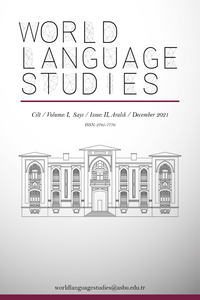Nathaniel Hawthorne’un Kızıl Damga’sında Hester Prynne’nın Değişimi
Nathaniel Hawthorne tarafından kaleme alınan ve 1850'de yayınlanan Kızıl Damga, Püriten kültürü ve inançlarına eleştirel bir bakış açısıyla on yedinci yüzyılda Püriten yaşam tarzının nasıl olduğuna ışık tutmaktadır. Roman, tüm insanlığın günahkâr olduğu ve sürekli şeytani güçlerin tehdidi altında olduğu fikrinden yola çıkarak adaletsiz yasaları, cezalandırma yöntemlerini ve çarpık gelenekleri anlatır. Hawthorne, sessizliği, özgüveni ve sevgisine olan inancıyla Püriten inancına meydan okuyan Hester gibi güçlü bir kadın karakter yaratarak, Püriten toplumunun ikiyüzlülüğü ve ahlaksızlığı ile sert teokrasisini etkili bir şekilde eleştirir. Hester, Püritenlerin gaddar tavırları karşısında toplumdan dışlanmış bir kişilikten saygın ve erdemli bir kişiliğe radikal bir değişim sergileyerek zaman ve mekânın ötesine geçer. Bu makalenin amacı, Hester Prynne'ın toplum içinde aşağılanması yoluyla karakter gelişimini ve ruhsal dönüşümünü ve Kızıl Harf “A”nın anlamının sembolik değişimini tartışmaktır. Aynı zamanda, Hester’ın kamusal imajındaki değişikliğin, azimli çalışması, kararlı tavırları ve güçlü iradesiyle nasıl yakından bağlantılı olduğunu feminist bir mercekle göstermeyi amaçlamaktadır ki bunların hepsi, günahını inkâr etmeyen; ancak Püriten toplumun ikiyüzlülüğüne meydan okuyan güçlü iradeli bir kadın olarak hayatta kalmasına katkıda bulunmuştur.
Anahtar Kelimeler:
Nathaniel Hawthorne, Kızıl Damga, Püriten, Hester, Pearl
Hester Prynne’s Transformation in Nathaniel Hawthorne’s The Scarlet
The Scarlet Letter penned by Nathaniel Hawthorne and published in 1850 sheds light on what a Puritan lifestyle was like in the seventeenth century with a critical perspective on the Puritan culture and beliefs. The novel portrays the unfair laws, punitive methods and distorted customs based on the idea that all mankind is sinful and they are constantly under the threat of demonic forces. The hypocrisy and depravity of the Puritan society as well as its harsh theocracy are effectively criticized by Hawthorne with the creation of such a strong female character as Hester, who defies the Puritan faith through her silence, self-confidence and belief in her love. Hester transcends time and space with her radical transformation from a social outcast to a respectable and virtuous personality in the face of the Puritans’ vicious manners. The objective of this paper is to discuss the character development and spiritual transformation of Hester Prynne through her public humiliation and the symbolic transformation of the meaning of the Scarlet Letter “A”. It also aims to demonstrate how the change in her public image was closely linked with her persevering work, adamant manners, and strong-will, which all contributed to her survival as a strong-minded woman not denying her sin but defying the hypocrisy of the Puritan society through a feminist lens.
Keywords:
Nathaniel Hawthorne, The Scarlet Letter, Puritan, Hester, Pearl,
___
- Baym, Nina (1976). The Shape of Hawthorne's Career. Ithaca: Cornell Univ. Press, p. 130. Baughman, Ernest W. (1967). “Public Confession and The Scarlet Letter”. The New England Quarterly, Vol. 40, No. 4, pp. 532-550. Emerson, R.W. (2008). Nature. New York: Kindle Edition. Felton, R. T (2006). Journey Into the Transcendentalists' New England. Berkeley: Roaring Forties Press. Gilbert and Gubar (1979). “The Madwoman in the Attic: The Woman Writer and the Nineteenth-Century Literary Imagination. New Haven: Yale Univ. Press, pp. 14, 36. Hawthorne, Nathaniel (1992). The Scarlet Letter. London: Wordsworth Classics. Leland S. Person, Jr. (1989). “Hester's Revenge: The Power of Silence in The Scarlet Letter”. Nineteenth-Century Literature, Vol. 43, No. 4, pp. 465-483. Nissenbaum, Stephen (1978). “The Firing of Nathaniel Hawthorne,” Essex Institute Historical Collections, 114, 59. Phillips, J (2010). Romanticism and Transcendentalism :( 1800–1860). New York. House Publications. Sganlon, Lawrence E. (1962). “The Heart of The Scarlet Letter”. Texas Studies in Literature and Language, Vol. 4, No. 2, pp. 198-213. Tassi, Nina (1998). “Hester's Prisons: Sex, Intellect, and Gender in "The Scarlet Letter"”. CEA Critic, Vol. 60, No. 3, pp. 23-36. Thoreau, H. D. (2004). Walden: or, Life in the Woods. Boston: Shambhala Press. T. Walter Herbert, Jr. (1988). “Nathaniel Hawthorne, Una Hawthorne, and The Scarlet Letter: Interactive Selfhoods and the Cultural Construction of Gender”. PMLA, Vol. 103, No. 3, pp. 285-297. Wilson, L. P. (2004). Thoreau, Emerson, and Transcendentalism. New York: IDG Books Worldwide, Inc.
- Başlangıç: 2021
- Yayıncı: Ankara Sosyal Bilimler Üniversitesi
